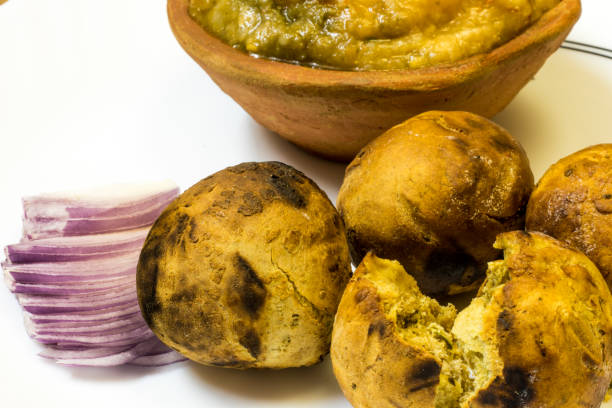Few dishes tell a story as rich and flavorful as Litti Chokha. Born in the rural heartlands of Bihar, this earthy combination of roasted wheat balls stuffed with sattu and smoky mashed vegetables was once the staple of farmers and laborers. Fast-forward to today, and you’ll find Litti Chokha plated on elegant ceramic ware, served with artistic garnishes in high-end restaurants and boutique cafes across India.
But how did this humble, rustic dish become a star on the fine dining table?
Let’s take a closer look at the incredible journey of Litti Chokha — from the mud kitchens of Bihar to gourmet menus in Delhi, Mumbai, and beyond.
🌾 Humble Beginnings: Food of the Fields

Litti Chokha has deep roots in the agrarian culture of Bihar, Jharkhand, and Eastern Uttar Pradesh. Traditionally, it was a farmer’s meal — simple, nutritious, and easy to prepare without elaborate utensils or ingredients.
- Litti is made by stuffing whole wheat dough with a spiced sattu (roasted gram flour) mixture, then roasting it over coal or cow dung fire.
- Chokha is a mashed mix of roasted or boiled vegetables like eggplant (baingan), tomato, and potato, flavored with mustard oil, garlic, chilies, and salt.
This meal was smoky, hearty, and high in energy, perfect for people doing long hours of physical labor.
Moreover, it didn’t require refrigeration, could be carried easily to the fields, and needed minimal utensils — a blessing in resource-scarce rural areas.
🧭 Cultural Symbolism: More Than Just Food
Litti Chokha is not just a dish — it’s a cultural identity. In Bihar, it’s served at weddings, community gatherings, religious events, and political campaigns. It symbolizes:
- Simplicity
- Self-sufficiency
- Pride in tradition
For many Biharis living outside the state, Litti Chokha is a taste of home — evoking nostalgia and emotional connection to their roots.
🛣️ On the Move: Street Food Revolution
The real transformation of Litti Chokha began when it entered the urban street food scene.
As migrants from Bihar and UP moved to cities like Delhi, Patna, Kolkata, and Mumbai, they brought their food traditions along. Small stalls started popping up, offering freshly roasted littis with chokha and a dollop of desi ghee — all for an affordable price.
It became a hit among:
- Office-goers looking for a filling lunch
- Students craving a taste of home
- Foodies eager to try something regional and authentic
Soon, Litti Chokha was no longer just a rural dish — it was a popular street food with mass appeal.
🍽️ Litti Goes Gourmet: Entry into Fine Dining
As India’s culinary scene matured, there was a growing demand for regional Indian cuisine that had long been overlooked in favor of Mughlai, Punjabi, or South Indian dishes. Chefs and restaurateurs began to re-explore native ingredients and cooking methods — and Litti Chokha caught their attention.
Here’s how Litti entered the fine dining spotlight:
- Presentation Upgrades: Chefs began serving mini-littis with bite-sized portions of chokha on tasting platters.
- Fusion Twists: Litti was paired with truffle oil, served with beetroot chokha, or turned into sliders and canapés.
- Artisanal Techniques: Traditional cooking methods like roasting over charcoal or using mustard oil were preserved, but ingredients were made more premium — organic flours, single-origin ghee, Himalayan pink salt, etc.
- Celebrity Chefs & Menus: Renowned chefs like Ranveer Brar and Kunal Kapur have spoken about Litti Chokha in culinary shows and added it to curated regional thalis.
🍴 From Roadside to Five-Star: A Tale of Transformation
Today, you’ll find Litti Chokha:
- As a street snack in Patna and Varanasi
- On delivery apps across India
- In wedding buffets
- At luxury hotels and food festivals like the Taj, ITC, and Indian Accent
What’s remarkable is that its core hasn’t changed — even when modernized, the dish retains its soulful, smoky essence.
🧂 Why Litti Chokha Works in All Settings
✅ 1. Nutritional Value
Rich in fiber, protein (thanks to sattu), and good fats (from mustard oil or ghee), Litti Chokha fits into modern health trends — gluten-free options are also being explored.
✅ 2. Sustainability
It uses local grains and seasonal vegetables, and has a low carbon footprint, making it a favorite for eco-conscious food movements.
✅ 3. Vegan/Vegetarian Friendly
The traditional recipe is entirely plant-based (unless ghee is added) — a big plus in urban, health-conscious markets.
✅ 4. Flavor Complexity
Smokiness from roasted vegetables, the pungent hit of mustard oil, the spice of green chilies, and the tang of lemon — Litti Chokha delivers layers of bold, balanced flavor.
👨🍳 Voices Behind the Change: Chefs & Homepreneurs
The rise of Litti Chokha owes a lot to:
- Home chefs and Bihari food entrepreneurs who brought the dish to pop-ups and catering businesses.
- YouTube cooks and food vloggers who popularized the recipe across languages.
- Food bloggers writing about regional delicacies and sharing authentic stories.
These voices elevated Litti Chokha from “poor man’s food” to “pride of Bihar.”
📝 Conclusion: Rooted in Tradition, Ready for the World
The journey of Litti Chokha is more than a culinary evolution — it’s a story of cultural pride, migration, adaptability, and rediscovery.
From rural kitchens and dusty fields to city sidewalks and Michelin-style menus, Litti Chokha has proven that simplicity, when done right, can be timeless and extraordinary.
So the next time you savor a plate of Litti Chokha — whether from a street vendor or a luxury dining room — remember that you’re tasting more than food. You’re tasting a legacy.